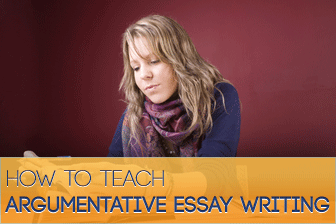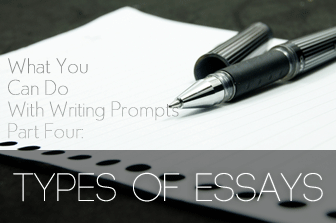How to Teach Argumentative Essay Writing


Something you could use for speaking, listening, reading and writing? The truth of the matter is, something like that does exist, and it is not a magic pill that is your answer. Writing prompts can be used in every aspect of language learning. The creative little sparks do not have to be limited to the top of a blank page. With a little creativity and a few language education skills, these prompts can make a difference in every area of your curriculum. This series looks at the myriad of uses for writing prompts, many to be used in writing class but others that can be used in conversation and discussion periods, extension activities and creative as well as academic writing. This installment looks at how writing prompts can target specific strategies for academic writing, aka types of essays.
This is the fourth part of the series.
Part One: What You Can Do With Writing Prompts Part One: Idea Generating
Part Two: What You Can Do With Writing Prompts Part Two: The Writing Process
Part Three: What You Can Do With Writing Prompts Part Three: The Parts of an Essay

Many students are taught how to write essays. They are, after all, the foundation for most writing assignments after a student finishes high school, but specific instruction on the essay often stops after the standard five paragraphs. Students learn how to write an introduction, a conclusion and the three supporting paragraphs that complete this simple writing formula, but for students who intend to attend higher education institutions in English, they will have more complicated writing demands. ESL students as well as native speakers will therefore benefit from walking through each of the following types of essays as preparation for collegiate level writing. When practicing essay writing with writing prompts, certain questions will tend to elicit a specific type of essay. (Some prompts can be answered with multiple organizational approaches but many require one kind of organization.)
Following you will find a brief explanation of each of six different essay styles and two writing prompts that can be used to elicit that specific organizational pattern in a student essay. Whether you walk through all of the essay styles with your students or limit yourselves to only some, your students will improve their flexibility and learn multiple options for the next time they receive an essay prompt.
Perhaps most common after the five-paragraph essay is the compare/contrast essay. The purpose of this essay is to prove one item’s superiority over another, show how two things are more similar or different than they appear, or to explain something less familiar by comparing it to something more familiar. To accomplish any of these purposes, the writer chooses points (usually three) on which to examine the two items in relation to one another. As a prewriting activity, you may want to have your students complete a Venn diagram on the two items they are comparing. This comparison can then be used to write the text of the essay.
The compare/contrast essay follows one of two typical structures. The writer either discusses all aspects of each item at one time in two separate paragraphs or discusses each aspect in its own paragraph. For the latter organization, three points of comparison would result in three body paragraphs each of which discusses both items. With the former, the writer would compose two body paragraphs each of which examines all three aspects. If you like, use writing prompts to elicit notes which your students can then organize in a compare/contrast pattern or have your students write the entire essay.
A writer can take two approaches to the classification essay. The first approach seeks to explain many things by grouping them into like classes or categories. For example, you may explain the governments of the world by grouping them into different types or classes of government. In a second approach, a writer may choose to write a classification essay to explain one thing by dividing it into smaller parts. For example, you may explain the U.S. government by breaking it into its three branches. The body of the essay then explains each class in one paragraph, defining it and explaining how it is different from the other classes or parts. Like the compare/contrast essay, you can use a writing prompt to generate notes which can be organized as if your students were going to write the essay or have your students write the entire composition depending on how much time you have to commit to the activity.
Many writing prompts can be answered using the cause/effect analysis structure. The purpose of this type of essay is to show the relationships between events or items. Generally, the writer takes one of three approaches when explaining a cause and effect relationship. The first situation is one in which multiple causes contribute to one effect. For example, there are many reasons that a person could get a cavity, including eating too much sugar and not brushing his teeth. This is a multiple cause situation. Other causes may have multiple effects. For example, not recycling depletes the world’s resources and increases landfills. This topic would elicit a multiple effect essay. In both of these cases, each cause or effect would comprise its own paragraph in the final essay. The third structure for a cause and effect essay is the causal chain. In this type of relationship, one event leads to another event which leads to another. For this type of situation, each step in the series would comprise one paragraph. To generate ideas for a cause/effect analysis essay, you may want your students to create a flowchart which shows the causes and effects she intends to discuss.
The process essay is a “how to” essay. Its aim is to instruct, explain or recreate an event, and the writer accomplishes this goal by walking through the chronological steps in a process. Depending on the steps and how much information is necessary for each one, each step may have its own paragraph in the essay or several steps may be grouped together at logical breaking points throughout the process. To approach a process essay, ask your students to list the steps in a process with which they are familiar. It could be ‘how to make spaghetti’, ‘how to change a tire’, or ‘how to clean a bathroom’ or any process which answers a writing prompt you assign. Have your students start by writing the steps as bullet points or numbered steps, not worrying about grammar or punctuation. Then have your students group those steps into logical divisions and write one paragraph about each of those divisions. The writer should also take a moment to explain any specific vocabulary necessary to explain the process and warn the reader of any troubles he or she may have when following the steps of the process.
Argument or persuasive essays attempt to persuade or convince the reader. When writing this type of essay, encourage your students to avoid subjects of preference, faith or belief since it is highly unlikely that the writer would be able to sway someone else in these matters. Instead, have your students choose topics that can be argued logically with facts, examples and logical reasoning. The writer should be especially aware of his audience for this type of composition since the entire purpose of the essay is so intimately tied to the person who will be reading it. Using a writing prompt, you may choose to have your students simply list the arguments that they would use to convince the reader, or you may want your students to articulate entire paragraphs about each reason. Either way, your students should organize their ideas so the most convincing reason appears last in the final piece. This leaves the reader with the strongest argument and most convincing finale to the essay. Your students should also plan to include a refutation in an argument/persuasive essay in which he explains why the opinion of the opposition is incorrect. This usually appears after the writer has presented all of the arguments in favor of his position on the topic.
The problem/solution essay is the most complicated of those mentioned here since it combines aspects of multiple essays. Firstly, it requires comparison and contrast when analyzing possible solutions. To determine which solution is the best among many, the writer must look at and evaluate each possible solution in relation to one another. The writer must also include a persuasive element in his or her essay once he has determined the best possible solution. Through persuasion, the writer will convince the reader that his solution is best. Finally, a problem solution essay should include some implementation plan for the best solution. This type of writing follows the organizational pattern in a process analysis essay. Ultimately, the writer of a problem solution essay examines a problem situation and determines a way to correct it, in the process explaining how that solution can be implemented. All of these elements should be included in a problem solution essay. Taking the composition one step at a time and then following the steps for each piece will make the writing process less intimidating and writing the essay less daunting.
The appropriate strategy depends on the purpose for writing. Some writing prompts can elicit a variety of response styles, but many encourage a particular type of essay as an answer. If you are trying to teach your students the different styles of academic essay writing, you may want to use writing prompts to ensure that they get practice on the specific type of essay which your class is studying. This will prevent your students from using a familiar organizational strategy repeatedly. Once your students are capable with each of these academic writing organizational strategies, they will be well on their ways to securing success in their academic futures.